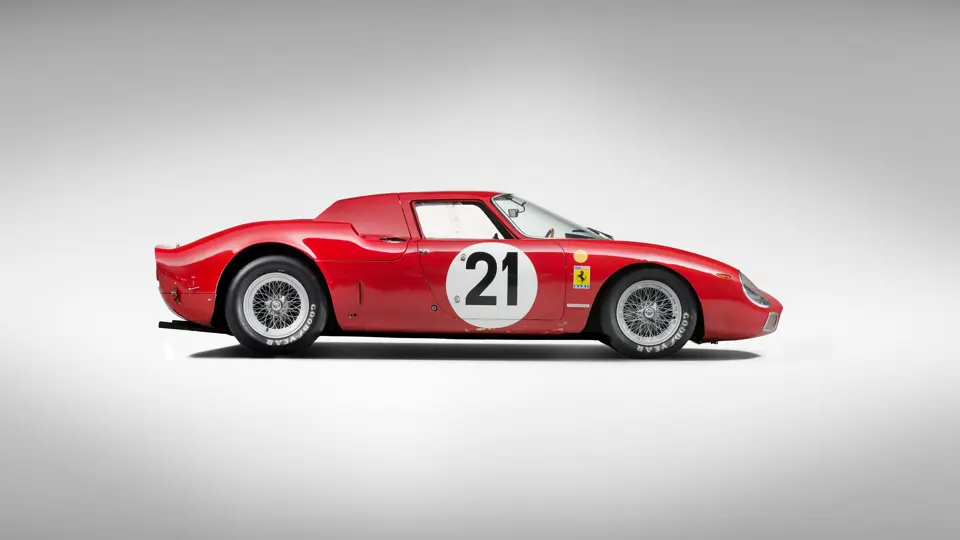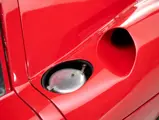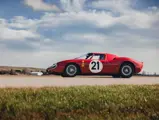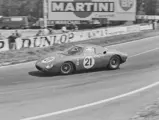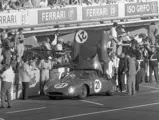In 1957 Chinetti formed the North American Racing Team (NART). NART was an important extension of what Scuderia Ferrari was doing on the track in Ferrari’s pursuit to earn coveted World Championship points in Prototype and GT racing. Each national racing team had its own significant moments in racing for Ferrari, but it was NART that stood out among the rest. The team was wildly successful over the years, competing in sports car racing, endurance races, and even fielding cars for the United States, Canadian, and Mexican Grands Prix. Chinetti’s NART attracted the top-tier driver talent and received the very best cars to compete from Maranello. The NART team proved a great promotional tool not only for Ferrari in North America, but also for Chinetti’s dealership, with customer demand built by the team’s racing success.
The NART team made its debut at Le Mans in 1957, and over the team’s near-quarter-of-a-century of competition history, it entered almost 70 cars in the world’s most legendary race. To date no team outside of Scuderia Ferrari itself has entered more Ferraris at Le Mans, and of all the cars ever campaigned by NART, one stands out among the rest…
FERRARI, ASCENDANT AT THE CIRCUIT DE LA SARTHE
Le Mans: The ultimate test of man and machine. No race in the world validates podium finishers in finer fashion or holds the 1st overall winner in higher regard. Of competitors having graced Circuit de la Sarthe in the race’s 101-year history, Ferrari’s impressive 11 victories place the Prancing Horse among the most successful marques of the world’s most challenging endurance race.
Ferrari’s first win at Le Mans came in a 166 MM entered by Lord Selsdon in 1949, co-driven by Luigi Chinetti. Chinetti delivered a legendary performance, driving nearly 23 hours of the race—a remarkable and all-but-unbelievable feat. The marque’s second win, and first entry for Scuderia Ferrari, came in 1954 with José Froilán González and Maurice Trintignant piloting a Ferrari 375 Plus to victory. Jaguar would dominate the next three years with the D-Type, with Ferrari’s best finish in that time being 3rd in 1956, with Oliver Gendebien and Maurice Trintignant driving a Ferrari 625 LM. In 1958 Scuderia Ferrari was once again triumphant at Le Mans with the Ferrari 250 TR58 driven by Phil Hill and Oliver Gendebien. The following season, 1959, would result in Aston Martin taking a 1-2 finish with the DBR1, while Ferrari 250 GTs took 3-4-5-and 6th place.
The field was always competitive, with some of the biggest automotive manufacturers in the world taking part—and heading into the 1960s, Ferrari was poised to send a message with a string of dominant performances, the likes of which Le Mans has seldom seen.
Ferrari’s semi-decade of dominance began in 1960, with an impressive 1-2 finish at Le Mans with Scuderia Ferrari’s 250 TR59/60 driven by Paul Frère and Oliver Gendebien taking 1st and Luigi Chinetti’s NART 250 TR59 driven by André Pilette and Ricardo Rodríguez finishing 2nd. Four of the remaining top 10 finishers were Ferraris. The year 1961 would mark a dominant performance for Ferrari with a 1-2-3 finish, with Scuderia Ferrari’s 250 TR61 driven by Phil Hill and Oliver Gendebien winning the race. Hill and Gendebien would repeat in 1962 behind the wheel of a Ferrari 330 TRi/LM, with a pair of 250 GTOs taking 2nd and 3rd. In 1963 Ferrari would win yet again, as SEFAC’s 250 P driven by Lorenzo Bandini and Ludovico Scarfiotti took victory, followed by Ferraris in 2-3-4-5-and 6th place.
This win—a fourth in a row—at the time tied Ferrari with Bentley and Alfa Romeo for most consecutive wins by a manufacturer at Le Mans. The tie would not last for long, as Ferrari would win once again in 1964 with SEFAC’s 275 P driven by Jean Guichet and Nino Vaccarella, the same chassis which had taken victory in 1963, followed by a pair of 330 Ps in 2nd and 3rd, and three 250 GTOs finishing in the top 10. This impressive fifth successive win set the stage for 1965, with Ferrari defending the longest consecutive win streak at Le Mans.
THE 250 LM: A 250 GT FOR LE MANS
Ever since the 1960 Formula 1 season, when Ferrari adopted a mid/rear-engine design for its successful grand prix car, Maranello had been a steady proponent of this mid/rear engine placement. This evolution gained traction through the small-displacement Dino prototypes of the early 1960s before Ferrari fitted a Testa Rossa-specification V-12 into the back of a prototype chassis, resulting in the legendary 250 P that won the 1963 24 Hours of Le Mans.
By mid-1963, Ferrari was in search of a replacement for the 250 GTO in sports car competition, and Enzo Ferrari naturally concluded that the 250 P could be transformed into a formidable GT-class Berlinetta. A barely modified version of the 250 P chassis was mounted with new alloy coachwork by Scaglietti, featuring a low roof with flying-buttress rear pillars.
After formally introducing the 250 LM at the 1963 Paris Salon, Ferrari struggled to receive homologation approval from the FIA, particularly when the proposed 3.0-litre engine was upgraded to a 3.3-litre single-overhead cam dry-sump version of the V-12, internally classified as the type 211. Frustrated by the FIA’s refusal to cooperate, Enzo Ferrari quickly lost interest in the 250 LM and allotted the minimal production run to privateers rather than any factory usage. In doing so, the 250 LM became the first rear-engine Ferrari sold to private customers, commencing a trend that lasts to this day.
Just 32 examples of the 250 LM were built up to mid-1966, and it remains one of the most desirable Ferraris of all time, encapsulating advanced engineering, sensuous coachwork design, and a successful competition resume.
ANATOMY OF A GIANT-KILLER
Completed in late-1964, chassis 5893 is the sixth 250 LM built (by numerical sequence), and it was distributed to Luigi Chinetti Motors, which in turn sold the car to Mrs Irene Young of Wilton, Connecticut. Mrs Young and her husband, Walter, also owned the 250 LM chassis 5901. Apparently, 5893 did not suit their immediate needs, considering they soon traded it back to Chinetti. This turn of events proved to be most fortunate, however, as otherwise the car would never have gone on to its greatest achievement.
Back in the hands of Chinetti Motors, this 250 LM became an immediate candidate for competition use by Chinetti’s North American Racing Team, better known as NART. By the mid-1960s, NART was one of just four privateer racing teams to enjoy direct support from the Ferrari factory and arguably the most important. In early 1965, the Ferrari was fitted with the more aerodynamically efficient longer nose by Piero Drogo, the factory-preferred coachbuilder who had clothed several of the marque’s prototype racecars.
The field for 1965 was a competitive one. Top honors were expected to be taken by one of the prototype Fords or Ferraris, contributing to the drama that surrounded Ford’s unsuccessful bid to acquire the Italian company. Ford/Shelby were well represented with five Daytona coupés, four GT40s, and two new 7.0-litre powered GT40s. A total of 12 Ferraris would be entered into the race with Ferrari countering Ford’s new GT40 with the 330 P2 and 365 P2. A total of five 250 LMs were also entered in the race, all by the national racing teams supported by Ferrari. Chinetti’s NART team entered a Ferrari 365 P2, #18 driven by Pedro Rodriguez and Nino Vaccarella. It also fielded this Ferrari 250 LM, chassis 5893, raced under #21 and driven by Masten Gregory and Jochen Rindt.










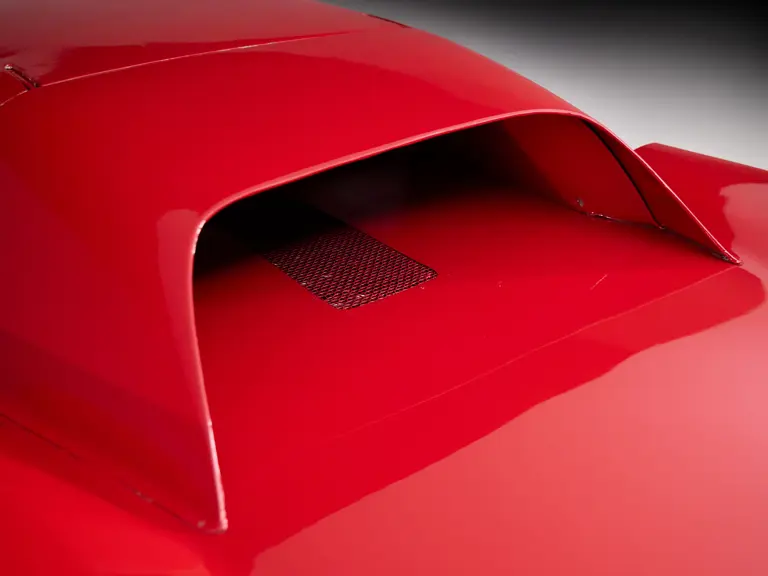







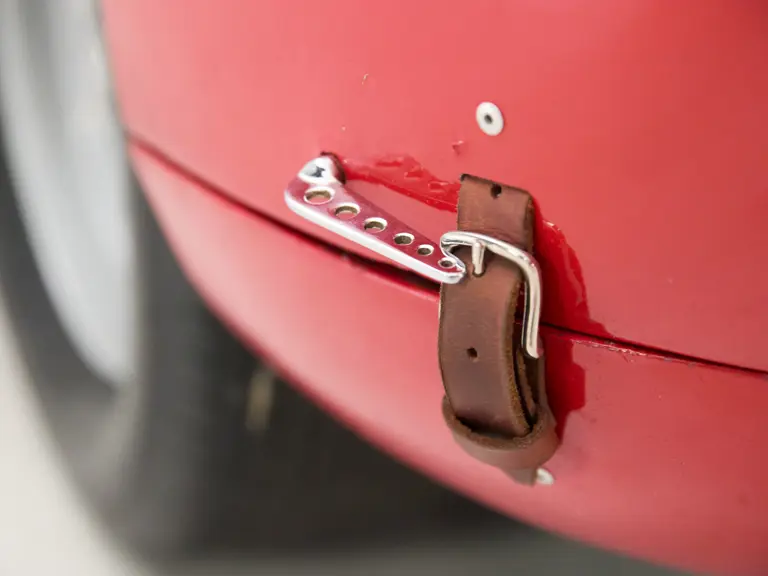

































































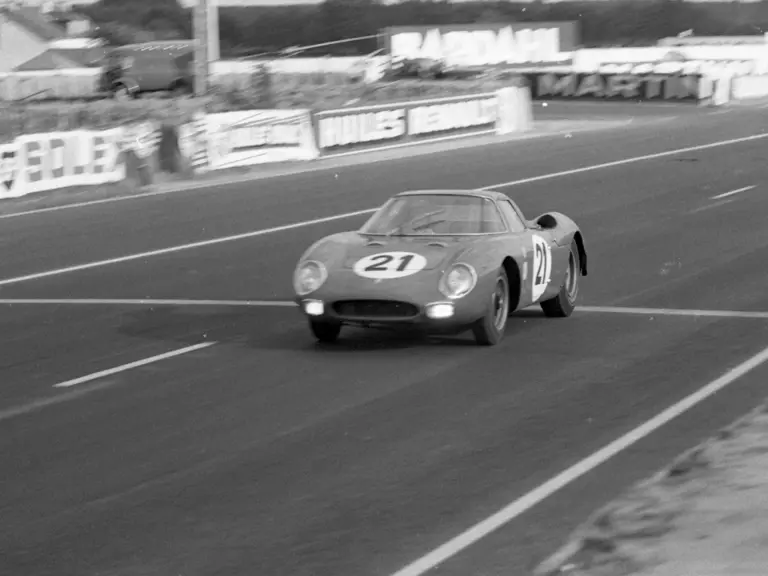






















 | Paris, France
| Paris, France
